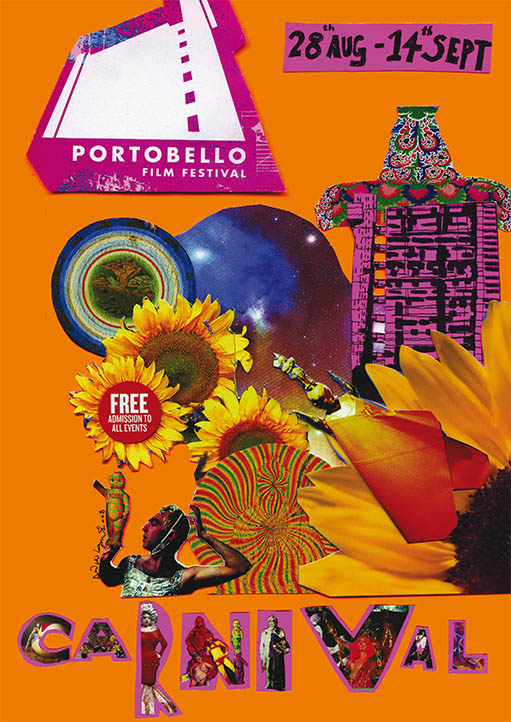PORTOBELLO
CARNIVAL FILM FESTIVAL 2008
1
Portobello Carnival Film Festival 2008
2 Lord
Holland’s Slavery to Work Scheme
3 The
Notting Dale Gypsies
4 Portobello
Busker Parades
5 1966
London Free School Michaelmas Fayre
6 1968
Interzone International Times Fair
7 1977
Two Sevens Clash Punky Reggae Party
8 1983/4
Aswad Live And Direct Carnival
9 1995
Hugh Grant Mas and Mayhem
PART 1
PORTOBELLO CARNIVAL FILM FESTIVAL 2008

Carnival was traditionally a Catholic festival taking
place on Shrove Tuesday or Mardi Gras before the beginning
of Lent, the period of fasting and abstinence. It is
a time when all caution is thrown to the winds, there
is much festivity and feasting, the Lords of Misrule
are celebrated in a wild party prior to a month or more
of self denial. It eventually became an opportunity
for slaves in the New World to temporarily throw off
their shackles.
Historically such delirious excesses go back beyond
Christianity and represent a very real need for people
to let their hair down, to be free albeit briefly from
the restraints of polite society, to make the dreary
day to day life of the rest of the year more bearable.
It was the theme of the fairs and festivals in the middle
ages, and the pagan orgies of Greece and Rome.
Its other contemporary roots lie in the magical hallucinatory
rituals of Africa and America, a powerful race memory
preserving vestiges of atavistic cultures going back
to the dawn of time displaced and ravaged by the slave
trade and colonialism. Notting Hill Carnival itself
is a direct descendant of the Carnival in Trinidad,
from where many migrants came to the UK and the Second
World War.
The art of Carnival, as celebrated in Brazil, New Orleans
and Notting Hill, can also trace many of its influences
back to the original Masquerade, the Carnival in Venice:
the dressing up and cross-dressing, the masks, the processions,
the circus element, the spectacle, the music, Punch
and Judy, Harlequin and Columbine, Commedia Del Arte,
the Comedy of Art.
For this is a joyous art form: it is happy, it is colourful,
it is exuberant, it is satirical, it doesn’t take
itself too preciously, it is the art of the people.
It doesn’t sit on its arse in museums, it gets
out in the streets, it is free, which matches the central
theme of the Portobello Film Festival, it makes people
happy. Even the morbid theme of the Mexican Day of the
Dead, another third world carnivalist collision between
church and paganism, is subverted by comedy and joy.
Portobello Film Festival proposes to weave together
some of the above themes that have contributed to the
phenomenon of Carnival and present them as a 21st century
compliment to the Notting Hill Carnival 2008.
Local historian Tom Vague
examines the origins, definitions, influences, traditions,
legends and myths of Notting Hill Carnival (Vague 48)
The Goose Fair Origin
The London Free School Fayre in 1966, the first modern
Notting Hill Carnival, is said to have been inspired
by an earlier Goose Fair or Fayre, in what could be
hippy confusion with the renowned Nottingham Goose Fair.
As described in Brewer’s Dictionary of Phrase
and Fable, Goose Fairs were ‘formerly held in
many English towns about the time of Michaelmas, when
geese were plentiful. That still held at Nottingham
was the most important. Tavistock Goosey Fair is still
held, though geese are seldom sold, goose lunches are
available.’ In another Goose Fair coincidence,
the 1966 procession began on Tavistock Road in late
September.
Michaelmas Day, the festival of St Michael and All Angels,
is September 29, a former Quarter-day when rents were
due, magistrates were chosen and geese were presented
to landlords from ancient times. In another tradition,
Elizabeth I is said to have started the custom in 1588.
Whilst dining on goose with Sir Neville Umfreyville
on her way to Tilbury, she made the toast “Death
to the Spanish Armada”, whereupon news arrived
of the weather assisted demise of the invasion fleet.
However this happened in July.
The May Events
During the reign of Elizabeth I, according
to the Puritan Phillip Stubbes’, throughout the
land in ‘May, Whitsunday, or other time, all the
young men and maids, old men and wives, run gadding
over night to the woods, groves and hills, and mountains,
where they spend all the night in pleasant pastimes;
and in the morning they return, bringing with them birch
and branches of trees, to deck their assemblies withal…
But the chiefest jewel they bring from thence is their
May-pole, which they bring home with great veneration.
‘They have twenty or forty yoke of oxen, every
ox having a sweet nose-gay of flowers placed on the
tip of his horns, and these oxen draw home this May-pole
(this stinking idol, rather), which is covered all over
with flowers and herbs, bound round about with strings,
from the top to the bottom, and sometimes painted with
variable colours, with two or three hundred men, women
and children following it with great devotion. And thus
being reared up, with handkerchiefs and flags hovering
on the top, they straw the ground round about it, set
up summer haules, bowers, and arbors hard by it. And
then fall they to dance about it, like as the heathen
people did at the dedication of the idols.’
In Notting Hill in Bygone Days the area was noted as
a venue of May dances and Jack in the Green wickerman
processions. JG Frazer described the Jack in the Green
leaf-clad mummer in The Golden Bough as a ‘relic
of tree-worship in modern Europe’, featuring a
chimney sweep in ‘a pyramidical framework of wickerwork’
covered in holly and ivy and crowned with flowers and
ribbons, at the head of a May day parade of fellow chimney
sweeps collecting gratuities
Carnevale, Fasching and Mardi Gras (Fat Tuesday)
In the Oxford Concise Dictionary, Carnival
is defined as the festivities in Roman Catholic countries
in the half-week or week before Lent, or riotous revelry;
reckless indulgence in something, carnival of bloodshed,
etc. The Latin term ‘Carne Vale’ means ‘farewell
to the flesh’ or ‘flight of the flesh’,
before the 45 day fast of Lent from Ash Wednesday till
Easter in March. The term dates back to the 16th century
and is derived from the Latin carne, carnovale, carnelevarium,
from caro – flesh and levare – put away.
The Carnevale in Venice dates back a thousand years,
and the Germans had a dubious sounding ‘Fasching’
carnival-style festival. The Paris Mardi Gras ‘Fat
Tuesday’ festival featured an ox crowned with
a fillet (presumably a ribbon or head-band rather than
a piece of meat or boned fish), which was paraded through
the streets with mock priests and a tin band, imitating
a Roman sacrificial procession.
Caribbean and New World Carnivals
The French took their Roman Catholic carnival
festival to Trinidad, in the form of dinners, balls
and fetes where slave masters dressed as slaves with
blackened faces at the culmination of the elite French
Creole social season. In Brazil, Cuba and Barbados ‘Crop
Over’ Carnivals developed without the French influence.
In New Orleans the first Mardi Gras krewes formed out
of aristocratic secret societies.
After the 1833 Emancipation Act abolished slavery in
the British empire, West Indians celebrated their liberation
with annual carnivals, using the European Catholic format
with an African cultural spin. The most famous in Port
of Spain, Trinidad, acquired an anti-slavery dimension
in the mas playing role reversals of former slaves mocking
former slave masters by dressing up, or masquerading,
in devil costumes. The ‘Canne Brulee’, cane
burning festival, celebrated with stick fights, fetes
and rum drinking, developed into mass carnivals mocking
authority.
The Porto Belo Carnival and the War of Jenkins’
Ear
By the 1720 Treaty of Utrecht Assiento, Britain
was transporting 5,000 African slaves a year to South
America. To curtail any further British trade guard-ships
patrolled the Spanish Main. In the late 1730s a war
over shipping rights was sparked by an incident in which
a British captain, suspected of smuggling, reputedly
had his ear torn off by a Spaniard. ‘The War of
Jenkins’ Ear’ began with a small fleet under
the command of Admiral Edward Vernon taking the Spanish
stronghold of Porto Belo (now in Panama). In all likelihood,
it was in celebration of this victory that the local
farmer Abraham Adams named his farmhouse, and hence
the lane/road to it. At the same time in New York there
was an uprising of Africans, Irish and Spanish known
as ‘the Slave Plot’ of 1741, brought about
by recruitment for the British war.
With some historical irony, in the 20th century the
former Portobello farmland became home to Afro-Caribbean,
Irish and Spanish communities, while Vernon Yard on
Portobello Road hosted the offices of Virgin Records
including the Frontline reggae label. Meanwhile back
in Porto Belo, Panama, the descendants of escaped African
slaves hold a proper Lent carnival in March.
The World Turned Upside Down
In the King Mob ruled 18th century of more
or less non-stop riots, rebellions and carnivalesque
revelries, English fairs with mock mayor ceremonies
were closer to pagan king killing rituals than Catholic
carnivals. William Hogarth’s 1761 ‘A View
from Cheapside’ depicts rowdy festivities featuring
a black horn player. In Old London, Edward Walford wrote
of hangings at Tyburn, ‘execution day, as it was
termed, must have been a carnival of frequent occurrence.’
John Wallis described a Northumberland Christmas ritual
in 1769, in which ‘young men march from village
to village, and from house to house, with music before
them, dressed in an antic (odd, grotesque) attire, and
before the entrance of every house entertain the family
with the antic dance with swords or spears in their
hands, erect and shining. This they call the sword-dance.
For their pains they are presented with a small gratuity
in money, more or less, according to every house-holder’s
ability. Their gratitude is expressed by firing a gun.’
Such activities were duly suppressed and more or less
ended by a combination of the Industrial Revolution,
the Protestant work ethic, labour laws and land enclosure.
part 2:
Lord Holland’s Slavery to Work Scheme
|





